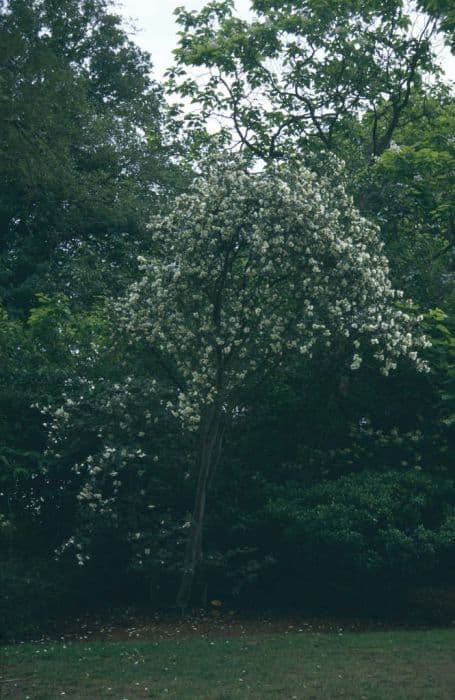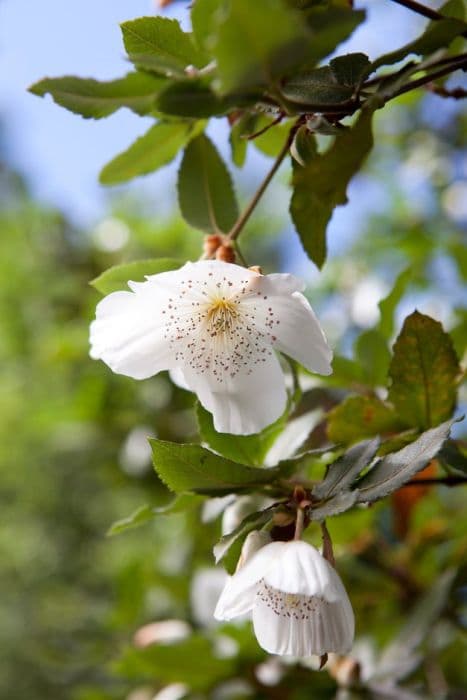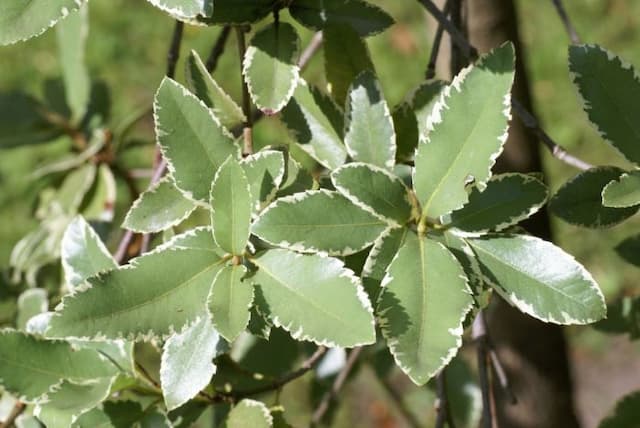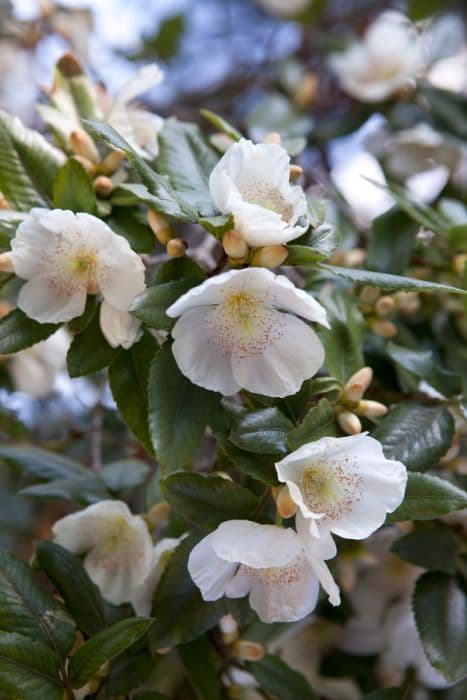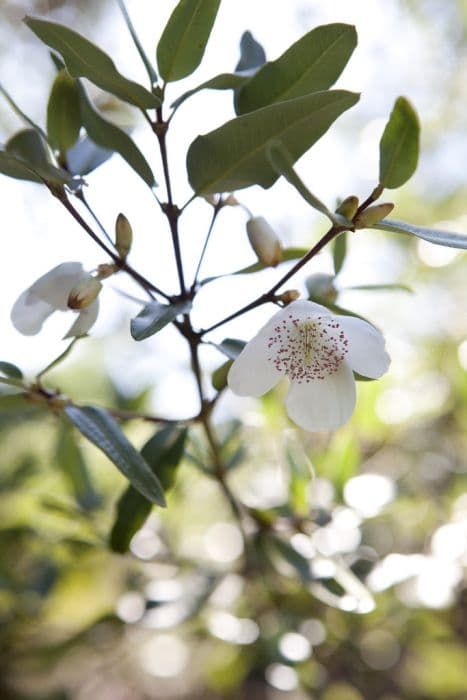Eucryphia Rostrevor Eucryphia × intermedia 'Rostrevor'

ABOUT
The Eucryphia × intermedia 'Rostrevor', commonly known as Eucryphia, is a striking ornamental shrub that boasts a profusion of flowers when in bloom. Its foliage is composed of glossy, evergreen leaves that provide a year-round display of lush greenery. The leaves are typically lance-shaped, offering a sleek and somewhat elongated appearance. During the flowering season, Eucryphia 'Rostrevor' becomes a focal point in the garden thanks to its large, white blossoms. These eye-catching flowers are bowl-shaped and possess a delicate, often frilly texture, exuding a soft and inviting feel. Some might say the petals appear almost waxy, contributing to their fresh and pristine look. At the heart of each flower, a cluster of prominent stamens can be noted, which are usually a bright golden-yellow color, creating a striking contrast against the pure white petals. These blooms are not only visually appealing but are also known to attract various pollinators such as bees. The overall appearance of Eucryphia 'Rostrevor' exudes elegance and can bring a touch of refined beauty to garden settings that are designed to showcase plants with visual interest throughout multiple seasons.
About this plant
 Names
NamesFamily
Cunoniaceae
Synonyms
Rostrevor Eucryphia
Common names
Eucryphia × intermedia 'Rostrevor'.
 Toxicity
ToxicityTo humans
The Eucryphia 'Rostrevor' plant, commonly known as Rostrevor Eucryphia, is not widely reported to be toxic to humans. There is limited information available on its toxicity, and it does not feature prominently on lists of toxic plants. However, as with many plants, it is generally advisable to avoid ingesting parts of this plant because the effects on humans are not well documented. If you suspect poisoning from any plant, seek medical advice promptly.
To pets
The Rostrevor Eucryphia is not specifically listed as a toxic plant to pets. However, the lack of data on its toxicity suggests that it should be treated with caution, as the effects on pets are not well established. To ensure the safety of your pets, it is best to prevent them from ingesting any parts of the plant. If you observe any signs of distress or suspect poisoning after your pet has come into contact with this plant, please consult a veterinarian.
 Characteristics
CharacteristicsLife cycle
Perennials
Foliage type
Evergreen
Color of leaves
Green
Flower color
White
Height
20 feet (6 meters)
Spread
10 feet (3 meters)
Plant type
Tree
Hardiness zones
9
Native area
Cultivar
Benefits
 General Benefits
General Benefits- Ornamental Appeal: Eucryphia × intermedia 'Rostrevor', commonly known as Rostrevor Eucryphia, has showy white flowers that are visually appealing and can enhance the aesthetic value of gardens and landscapes.
- Attracts Pollinators: The flowers provide nectar and pollen for bees and other pollinating insects, supporting local biodiversity.
- Shade Provision: As a tree, Rostrevor Eucryphia can provide shade in gardens and public spaces, making outdoor areas more comfortable during sunny days.
- Windbreak: Its canopy and structure can act as a natural windbreak, protecting smaller plants and outdoor spaces from strong winds.
- Seasonal Interest: It offers seasonal interest with its flowering period in late summer, a time when many other plants may not be in bloom.
- Habitat Provider: The tree can serve as a habitat for birds and wildlife, offering shelter and nesting opportunities.
 Medical Properties
Medical PropertiesThis plant is not used for medical purposes.
 Air-purifying Qualities
Air-purifying QualitiesThis plant is not specifically known for air purifying qualities.
 Other Uses
Other Uses- Furniture Polish: The waxy leaves of Eucryphia × intermedia 'Rostrevor' can be used to make a natural furniture polish.
- Insect Deterrent: The plant's natural oils may act as an insect deterrent when the leaves are crushed and spread in areas where insects are unwanted.
- Photography: Due to its beautiful and large white flowers, the plant can be used as a backdrop or subject in outdoor photography.
- Floral Arrangements: The striking flowers can be used in fresh floral arrangements, adding elegance and fragrance.
- Culinary Garnish: While not commonly eaten, the flowers could be used as an edible garnish for special culinary presentations where ornamentation is key, provided they are free of pesticides.
- Educational Tool: The plant can be used in botany education to show the characteristics of hybrid plants and the Eucryphiaceae family.
- Art Supplies: Dried branches and seed pods could potentially be used in arts and crafts, such as rustic wreath making or as natural paintbrushes.
- Wedding Decor: Its attractive blooms and foliage make it a candidate for wedding ceremony decorations, especially in outdoor settings.
- Bird Habitat: The dense growth can provide shelter and nesting opportunities for small birds.
- Dye Production: The bark and flowers may be used in the production of natural dyes for fabrics or artwork, offering subtle colors.
Interesting Facts
 Feng Shui
Feng ShuiThe Eucryphia is not used in Feng Shui practice.
 Zodiac Sign Compitability
Zodiac Sign CompitabilityThe Eucryphia is not used in astrology practice.
 Plant Symbolism
Plant Symbolism- Rarity: Eucryphia × intermedia 'Rostrevor' is a hybrid plant, symbolizing a uniqueness that comes from rarity and special origin.
- Overcoming Challenges: As a hybrid, the Rostrevor hybrid might represent the beauty and strength that can arise from overcoming the challenges of crossbreeding and cultivation.
- Beauty: With its attractive flowers, the Rostrevor hybrid is often associated with raw natural beauty, symbolizing the appreciation of aesthetics in all forms.
- Purity: The white flowers of the Rostrevor hybrid are commonly linked with purity and innocence, representing clarity and simplicity in a complex world.
 Water
WaterThe Rostrevor Eucryphia should be watered deeply to ensure that the soil is moist but not waterlogged, typically requiring about 1-2 gallons of water per week in the absence of rainfall. During hot, dry periods, watering frequency should be increased to twice a week, and during cooler, wetter seasons, reduce watering to when the top few inches of soil are dry to the touch. It's important to avoid overhead watering to prevent fungal diseases; instead, water directly at the base of the plant. Adjustments to the watering schedule should be made according to the plant's response and weather conditions.
 Light
LightRostrevor Eucryphia thrives best in full sun to partial shade conditions. A location that receives morning sunlight and some afternoon shade is ideal to protect it from the intense heat of the day. It is important to ensure that the plant gets at least 4-6 hours of direct sunlight each day for optimal growth and flowering.
 Temperature
TemperatureRostrevor Eucryphia prefers a temperate climate and can tolerate temperatures as low as 20°F and as high as 90°F. However, the ideal temperature range for this plant is between 60°F and 70°F. Protection from extreme cold and frost is crucial for the survival of the plant.
 Pruning
PruningRostrevor Eucryphia requires occasional pruning to maintain its shape and remove any dead or diseased branches. The best time to prune is immediately after flowering has finished, usually in late summer or early fall. This allows the plant to form buds for the next season's flowers. Pruning should be done sparingly to avoid stimulating excessive growth at the expense of flowers.
 Cleaning
CleaningAs needed
 Soil
SoilRostrevor eucryphia prefers well-draining soil rich in organic matter with a slightly acidic to neutral pH between 5.5 and 7. A mix of two parts loam, one part peat, and one part sand or perlite would be ideal for ensuring proper drainage and root health.
 Repotting
RepottingRostrevor eucryphia typically does not require frequent repotting; it should be repotted every 3 to 5 years or when it becomes root-bound. Choose a slightly larger pot to allow for continued growth.
 Humidity & Misting
Humidity & MistingRostrevor eucryphia thrives best in moderate to high humidity levels, ideally between 50-70%. It does well outdoors in its natural habitat where moisture is ample or in a garden with similar humidity conditions.
 Suitable locations
Suitable locationsIndoor
Ensure bright light, moderate humidity, and well-draining soil.
Outdoor
Plant in sun/part shade, shelter from wind, well-draining soil.
Hardiness zone
7-9 USDA
 Life cycle
Life cycleThe Eucryphia × intermedia 'Rostrevor', commonly known as Rostrevor Eucryphia, starts its life as a seed, requiring stratification to break dormancy. Upon germination in suitable conditions of soil and climate, the seedling emerges and transitions into a juvenile phase, where it establishes its root system and begins foliage growth. As it matures, the Rostrevor Eucryphia enters into an active growth phase, developing a woody structure and branching habit characteristic of the species. During the reproductive stage, it produces creamy-white, often fragrant flowers, typically in late summer, which are pollinated by insects. Following successful pollination, seeds form and disperse, either by wind or wildlife, completing the reproductive cycle. The plant continues to grow and may live for many years, reaching its mature phase with a substantial size, flowering annually as it maintains its perennial lifecycle.
 Propogation
PropogationPropogation time
Summer-autumn
Eucryphia × intermedia 'Rostrevor', commonly known as Rostrevor eucryphia, is typically propagated using semi-hardwood cuttings. This method is usually performed in late summer. To propagate from cuttings, a 4 to 6-inch-long cutting is taken from a healthy, semi-hardwood portion of the plant. The lower leaves are removed, and the cut end may be treated with a rooting hormone to encourage root development. The cutting is then planted in a well-draining potting mix and kept in a warm, humid environment until roots have developed, which usually takes a few weeks to a few months. During this time, the cutting should be kept out of direct sunlight and watered regularly to maintain moist soil conditions without becoming waterlogged. Once the cutting has rooted, it can be gradually acclimated to outdoor conditions and eventually planted in its permanent location.
